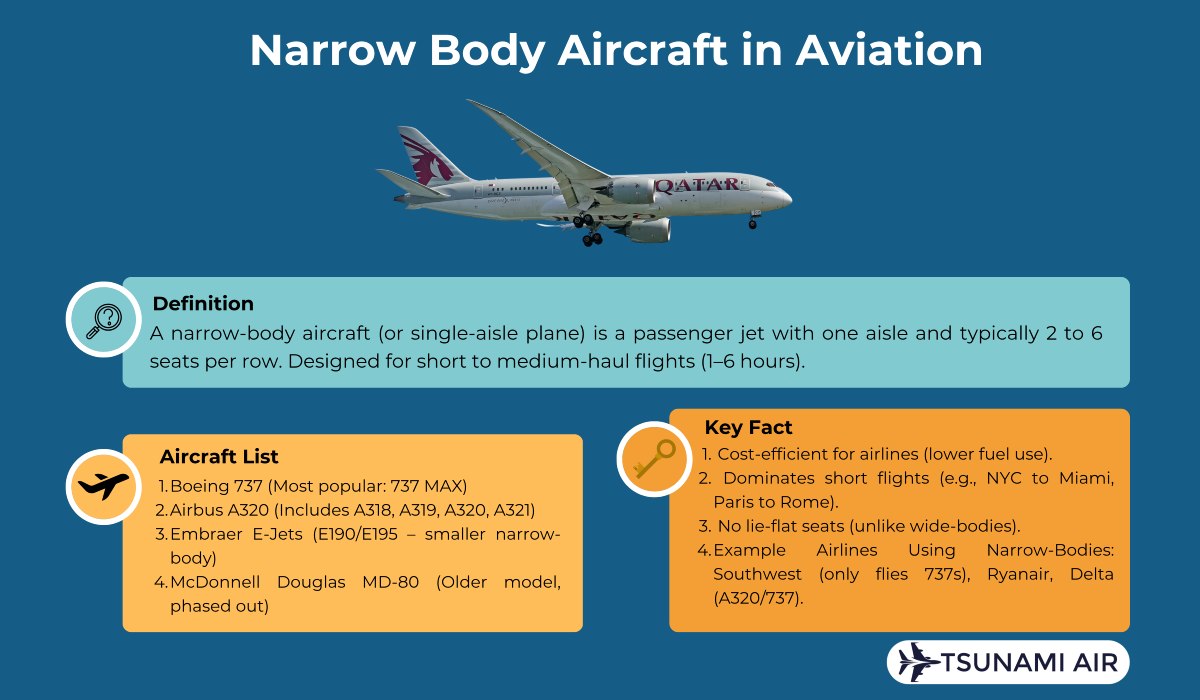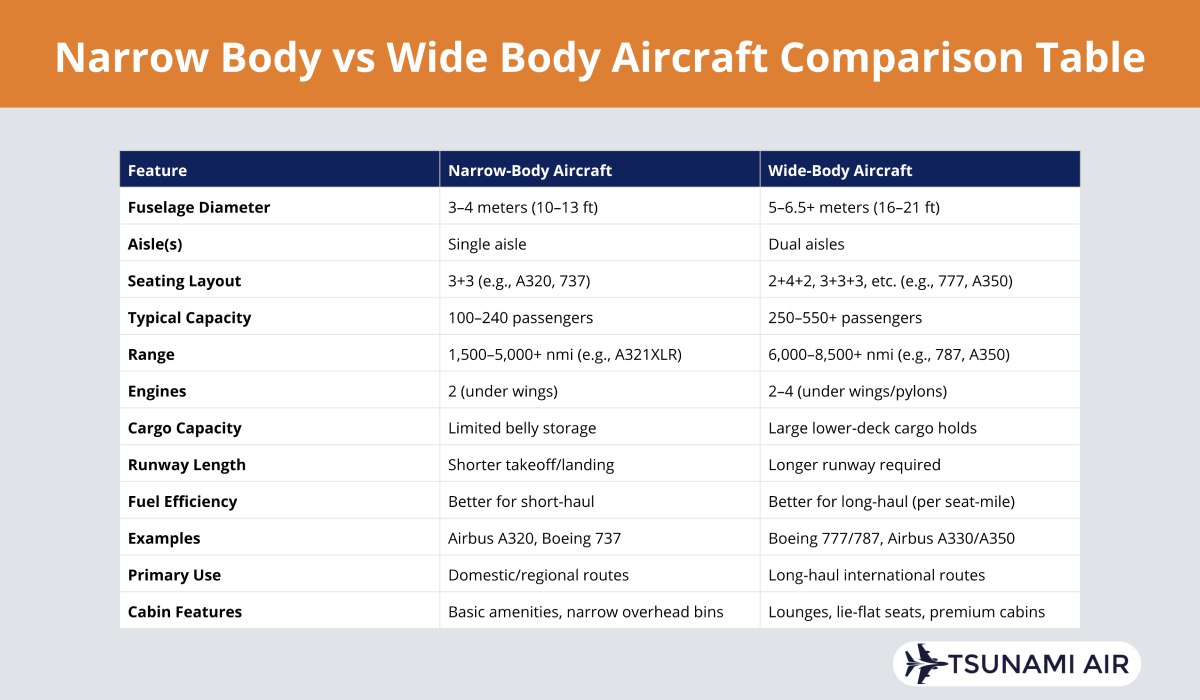Narrow-body Aircraft: Definition, Difference, List
Jim Goodrich • • Reading time: 6 min

Narrow-body aircraft is a category of airliner characterized by a single aisle and seating configuration that accommodates two to six passengers per row. Narrow-body aircraft dominate the market for short to medium-haul operations and serve as the backbone of many airline fleets. The series of narrow-body aircraft includes various models distinguished by their engines, maintenance requirements, and family classifications. Understand the definition, types, and examples of narrow-body aircraft along with their engine configurations, operational roles, and fleet integration.
The distinction between narrow-body and wide-body aircraft lies in fuselage width, aisle count, seating capacity, and operational range. Narrow-body aircraft feature a single aisle and a fuselage width of 3 to 4 meters (10 to 13 feet). These aircraft accommodate two to six passengers per row and seat between 100 and 200 passengers depending on configuration. Wide-body aircraft have twin or more aisles and a fuselage width of 5 to 6 meters (16.4 to 19.7 feet). They accommodate seven to ten passengers per row and seat between 200 and 850 passengers. Narrow-body aircraft like the Boeing 757-200 achieve up to 5,000 miles (8,046.72 kilometers) while wide-body aircraft like the Airbus A350-900 reach 14,000 miles (22,530.88 kilometers).
The Boeing 737, manufactured in the USA, accommodates between 85 and 215 passengers. The Airbus A320, produced in Europe, seats between 140 and 240 passengers. Embraer E-Jets, manufactured in Brazil, carry between 80 and 124 passengers. The Bombardier CRJ Series, produced in Canada, accommodates between 50 and 100 passengers. Other notable narrow-body aircraft include the Boeing 717, COMAC C919, and Sukhoi Superjet 100. Airlines use these aircraft for short to medium-haul flights, optimizing fuel efficiency and reducing operating costs compared to wide-body aircraft.
What are narrow-body planes?
Narrow-body planes are single-aisle aircraft designed with efficiency in mind, featuring a compact cabin with one central aisle and seating arrangements typically accommodating up to six seats per row. Narrow-body aircraft have a diameter of less than 4 metres (13.12 feet), allowing up to six seats per row in various configurations. Airlines use narrow-body planes for short-haul international and domestic flights, optimizing fuel efficiency and operating costs. The Boeing 737 and Airbus A320 family serve as prime examples of narrow-body aircraft widely adopted globally. Single-aisle designs facilitate quicker boarding and deplaning, maintaining tight schedules for airlines. Narrow-body planes accommodate fewer passengers compared to widebody aircraft, making them ideal for routes with lower demand.

Narrow-body aircraft dominate the narrow-body planes market, with Boeing and Airbus leading as the primary manufacturers. The Airbus A320 family incorporates advanced technology, including fly-by-wire systems, which enhance efficiency and pilot experience. Airbus A320 technology sets a benchmark in the industry, contributing to its widespread adoption. The Boeing 757 achieves a longer range compared to smaller models like the Embraer E-Jets and Bombardier CRJ, making it suitable for extended short-haul and medium-haul flights. The range varies across models, with the Boeing 757 outperforming others in its class.
The Airbus A320 capacity ranges from 140 to 240 passengers, depending on configuration. Boeing 737 capacity ranges from 85 to 215 passengers, accommodating various seating layouts. Embraer E-Jets carry 80 to 124 passengers, while the Airbus A220 accommodates 100 to 160 passengers. Bombardier CRJ capacity is between 50 and 100 passengers, optimizing regional operations. Aircraft layout plays a vital part in operational efficiency, with single-aisle designs reducing boarding and deplaning times.
Efficiency and layout features define the operational benefits of narrow-body aircraft fuselage shapes and seating arrangements. Boeing 737 efficiency stems from its reliable design and fuel economy, maintaining its status as a popular narrowbody aircraft. Airbus A220 efficiency results from its modern design, offering better performance on medium-haul routes. Embraer E-Jets efficiency supports regional flight operations, while Bombardier CRJ efficiency proves advantageous in smaller markets. Narrow-body aircraft layout includes configurations like 3 x 3, 2 x 3, and 2 x 2 seating, split by the aisle. Fuselage width measures less than 4 meters (13.12 feet), providing compact design while maximizing passenger comfort and operational cost-effectiveness.
What is the difference between narrowbody and widebody aircraft?

The difference between narrowbody and widebody aircraft is explained in the table below.
Criteria | Narrowbody Aircraft | Widebody Aircraft |
Aisle Count | Single aisle | Two or more aisles |
Fuselage Width | 3 to 4 meters (10 to 13 feet) | 5 to 6 meters (16.4 to 19.7 feet) |
Seating Abreast | 2 to 6 passengers | 7 to 10 passengers |
Typical Capacity | 100 to 200 passengers | 200 to 850 passengers |
Operational Range | Short to medium-haul | Long-haul |
Example Models | Boeing 737, Airbus A320 | Boeing 777, Airbus A330 |
Maximum Range | Up to 5,000 miles (e.g., Boeing 757-200) | Up to 14,000 miles (e.g., Airbus A350-900) |
Passenger Capacity | Boeing 737: up to 200; Airbus A320: up to 180 | Boeing 777: up to 440; Airbus A330: up to 400 |
Primary Use | Regional and short-haul flights | International and long-haul flights |
What is the length of the world's longest narrow-body flight?
The length of the world's longest narrow-body flight is 3,540 nautical miles (6,556 kilometers) for SAS Flight SK925 from Copenhagen to Washington, DC. SAS Flight SK925 operates with an Airbus A321neo (A321LR), showcasing the advanced capabilities of narrow-body aircraft. The flight duration between Copenhagen and Washington, DC, is 9 hours and 30 minutes. Narrow-body aircraft like the A321LR demonstrate efficiency in bridging continents for long-haul travel.
Other notable long-haul narrow-body routes include the Nice to Newark flight, which spans 3,482 nautical miles (6,448 kilometers) and operates with a duration of 9 hours and 20 minutes. The Milan Malpensa to Newark route covers 3,351 nautical miles (6,206 kilometers) and lasts around 9 hours. These routes highlight the efficiency of narrow-body aircraft in providing direct connections between distant regions. Narrow-body aircraft achieve this by utilizing advanced fuel-efficient designs and extended-range capabilities. The Nice to Newark route exemplifies how single-aisle planes can effectively serve transatlantic travel demands while maintaining operational viability.
Study of hypothetical routes suggests potential for even longer flights reaching up to 3,940 nautical miles (7,297 kilometers). Such routes will connect destinations in South America, though they remain speculative and non-operational at present. Discussions about these extended distances underscore the evolving position of narrow-body aircraft in global aviation. The upcoming Airbus A321XLR aims to further enhance the range and payload capacity of narrow-body aircraft. This advancement will enable airlines to operate more efficient and direct routes across continents, redefining air travel dynamics. Narrow-body aircraft increasingly support long-haul operations, demonstrating their ability to bridge distant regions reliably.
What is a list of narrow-body aircraft?
A list of narrow-body aircraft is provided in the table below.
Aircraft Model | Manufacturer | Country of Origin | Single-Aisle Configuration | Cabin Width (meters) | Classification |
Boeing 737 | Boeing | USA | Single aisle, 6-abreast | 3.8 | Narrow-body |
Airbus A320 | Airbus | Europe | Single aisle, 6-abreast | 3.7 | Narrow-body |
Boeing 757 | Boeing | USA | Single aisle, 6-abreast | 3.5 | Narrow-body |
Embraer E-Jets (E170-E195) | Embraer | Brazil | Single aisle, 4-abreast | 2.7 | Regional narrow-body |
Bombardier CRJ Series | Bombardier | Canada | Single aisle, 2-abreast | 2.5 | Regional narrow-body |
Boeing 717 | Boeing (McDonnell Douglas) | USA | Single aisle, 5-abreast | 3.3 | Smaller narrow-body |
COMAC C919 | COMAC | China | Single aisle, 6-abreast | 3.9 | Narrow-body |
Sukhoi Superjet 100 | Sukhoi Civil Aircraft Co. | Russia | Single aisle, 5-abreast | 3.2 | Regional narrow-body |